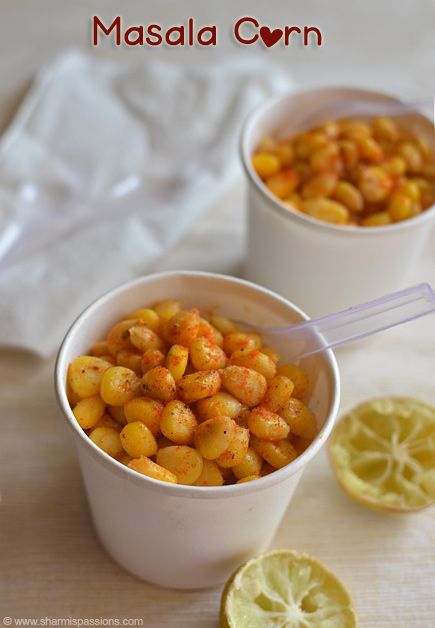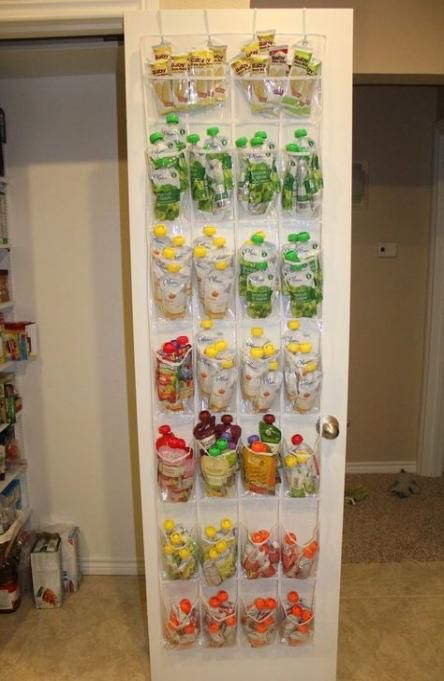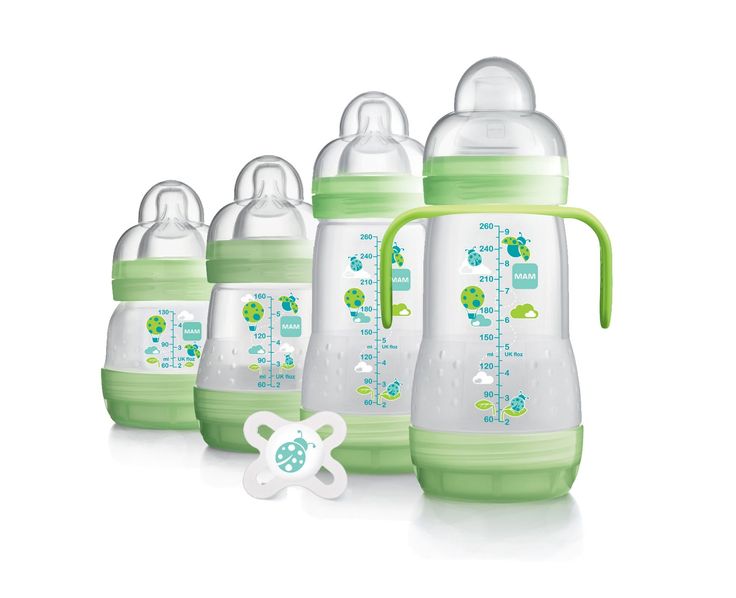Chick pea baby food recipe
Chickpeas for Babies (Baby Chickpea Puree Recipe)
↓ RECIPE ↓ VIDEO
Are chickpeas safe for babies? Yes, you can make pureed chickpeas for babies as part of baby led weaning. Learn when it is safe to introduce chickpea recipes for babies, and get a recipe for baby hummus! You’ll love this easy and healthy homemade baby food recipe that you can modify for the whole family to enjoy. This chickpea dip is naturally plant based, gluten free, vegetarian, and vegan.
Considering making chickpeas for baby? Chickpeas (AKA garbanzo beans or chana) are a great way to introduce some plant based protein, iron, and fiber into your baby’s diet.
This chickpeas baby food has a special little twist to help increase the amount of iron baby absorbs from the chickpeas. It’s important that babies are introduced to iron-rich foods soon after starting solids if they are breastfed.
According to the NIH, the iron is breastmilk is not sufficient for the needs of babies older than 6 months. Foods rich in iron, such as baby chickpeas, are important to help prevent iron deficiency anemia in babies and toddlers.
Do you like free things?
Get new recipe ideas biweekly, our 5-Day Air Fryer Quick Start Guide, and more totally FREE exclusive goodies!
First Name Email
We won't send you spam. Unsubscribe at any time.
Some other iron-rich foods for babies include iron-fortified baby cereals and beef baby food. Some picky eaters are slow to accept meat, making the plant-based iron sources even more important. Chickpeas and other legumes are also some of the best whole food sources of protein for vegans and vegetarians.
Jump to:- ❓ When should you introduce chickpeas to babies?
- 🤔 Are chickpeas an allergen for babies?
- ⭐ Health Benefits of Chickpeas for Babies
- 🥘 Are canned chickpeas OK for babies?
- 🥣 What to Mix with Chickpeas for Babies
- 🔪 How to Prepare Canned Chickpeas for Baby
- 🌡️ How to Store Chickpea Puree
- 📋 Nutritional Value of Chickpeas
- 💭 Expert Tips from a Dietitian
- FAQs
- 👩🏻🍳 Other Baby Food Recipes
- The Disclaimer…
- 📖 Recipe
- 💬 Comments
❓
When should you introduce chickpeas to babies?At what age can babies eat chickpeas? Babies can try chickpea puree when they are old enough to eat solid foods and finger foods. This is generally at around age 6 months.
This is generally at around age 6 months.
That said, all children are different, and you should ask your pediatrician if you have any questions about your child’s diet. If you’re pureeing canned chickpeas, make sure to get the ones with no added salt.
When can babies eat whole chickpeas? Whole chickpeas may be a choking hazard, so you should mash chickpeas or puree them before giving to a baby. Toddlers may also enjoy chickpea patties (baby falafel).
🤔
Are chickpeas an allergen for babies?Chickpeas are not one of the nine most common food allergens. However, there appears to be a cross-reactivity between chickpeas and peas and lentils (source). That means baby may be more likely to have a negative reaction to chickpeas if there is a known pea or lentil allergy.
⭐ Health Benefits of Chickpeas for BabiesWhy make baby chickpeas? Here are some benefits of chickpeas for 1 year old (and a bit younger):
- Plant-Based Protein: Legumes like chickpeas are rich in protein, which is necessary for healthy growth and development of the bones and muscles.
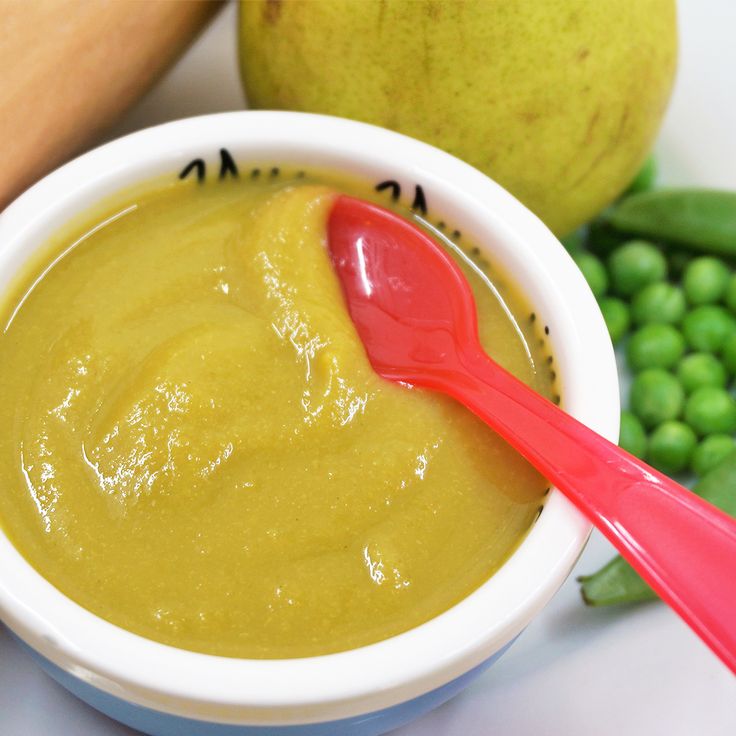 Vegan and vegetarian families especially should ensure everyone in the family gets legumes and other plant proteins in the diet.
Vegan and vegetarian families especially should ensure everyone in the family gets legumes and other plant proteins in the diet. - Iron: It’s generally recommended that one of baby’s first foods is an excellent source of iron to help prevent anemia. In this recipe, the vitamin C from the citrus juice helps improve the absorption of the non-heme iron in the chickpeas. In other words, baby gets an iron boost when you combine vitamin C and plant-based iron sources. Vitamin C also helps support healthy immunity!
- Fiber: Garbanzo beans are rich in fiber. Fiber is important for healthy digestion and a healthy heart.
- Introduce baby to new flavors: Introducing babies to a wide variety of flavors early may help them to expand their palate. They may be less likely to be picky eaters in later years as a result (though there are no guarantees). Why not make one of the first foods this delicious hummus for babies?
You can puree canned chickpeas for babies. However, I recommend the chickpeas have no added salt and are in BPA-free cans.
However, I recommend the chickpeas have no added salt and are in BPA-free cans.
It’s better to avoid added salt in baby’s food, so they don’t develop a lifelong preference for salty foods. The FDA has already banned the use of BPA in baby bottles and sippy cups. It makes sense to try and avoid BPA in the other food packaging of items fed to baby as well.
You can use dry chickpeas in this recipe if you pressure cook them to make them very soft. Make sure to remove any small stones or other debris from the dried chickpeas before you cook them. Don’t add salt or baking soda to them, just cooking them in water is perfect.
Dried beans tend to be cheaper but a little more work than canned beans. Choose the option that fits your budget and lifestyle best.
Do you have to cook chickpeas for babies?Canned chickpeas are already cooked, and do not need to be cooked again before eating. Dried chickpeas must be cooked before eating.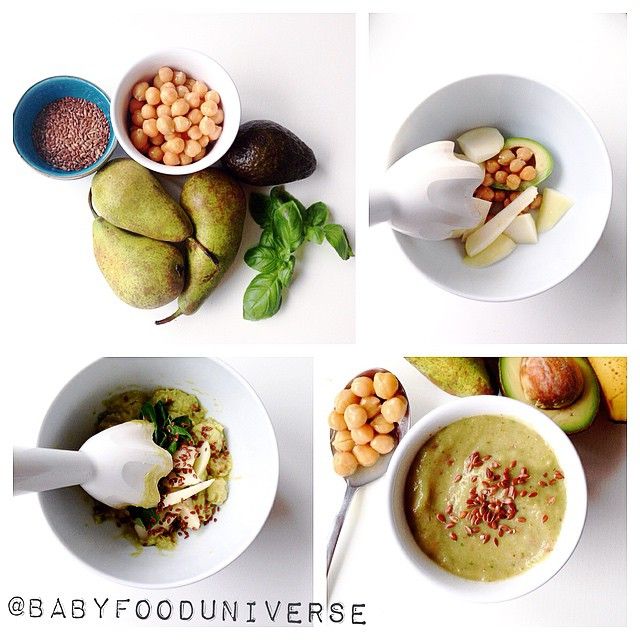
When baby starts solids, I think it’s smart to start with simple foods and recipes like this one. If baby has a negative reaction to a recipe, starting simply makes it easy to figure out which food was the issue. As baby is introduced to a wider array of foods, you can try more complex recipes.
🥣 What to Mix with Chickpeas for BabiesWhat goes well with chickpeas for babies? I’m adding citrus (fresh lemon juice or fresh orange juice) to this hummus for babies. Vitamin C foods help make the iron in chickpeas more available to the body.
Here’s a list of foods to add to chickpeas for babies. Cook the fruits and veggies first (except the avocado) to make them soft and easier to blend:
- Cauliflower
- Sweet potatoes
- Roasted red peppers
- Carrots
- Cooked apple (applesauce)
- Pear sauce
- Green beans
- Mashed banana
- Pumpkin puree
- Cooked squash
- Avocado
- Coconut milk
- Plain yogurt
Another fun idea I tried was roasted beetroot, which made the chickpeas a lovely pink-purple color.
According to the AAP, you should not introduce beets to babies before age 3 months due to their high naturally occurring nitrate content. (They also say don't introduce complementary foods to babies before ages 4-6 months anyway.)
A word of caution- beets can change the color of what is left in baby’s diaper. If you don’t remember you gave your baby beets, the color change can be quite scary! Some may choose to hold off on the beets until baby is older, and that is ok.
🔪 How to Prepare Canned Chickpeas for BabyDrain a 15 ounce can of chickpeas (with no salt added) well. Place the chickpeas in a food processor or high-speed blender. Add 2 tablespoons of freshly squeezed lemon juice or orange juice.
If you’re making this whole batch for baby (you’ll need to freeze some) add ¼ cup water. Blend until smooth. You will have to stop the food processor several times, scraping down the sides with a spatula, to get a smooth puree.
Add additional water if needed. Don’t forget you can blend in additional cooked veggies if you wish!
Don’t forget you can blend in additional cooked veggies if you wish!
Leftover chickpea puree can be kept in a covered container in the fridge for 3-4 days. You can also freeze small portions of pureed chickpeas in ice cube trays. Pack the cubes in freezer bags with the air pressed out for longer term freezer storage.
📋 Nutritional Value of ChickpeasHere is the nutrition information for chickpeas (one half cup of boiled chickpeas, no salt). Nutrition information is for one adult serving of chickpeas per Cronometer. Babies new to solids will only try a small taste of chickpea puree.
- Calories: 134
- Total carbohydrates: 22 grams
- Fiber: 6 grams
- Net carbohydrates: 16 grams
- Added sugar: 0 grams
- Fat: 2 grams
- Saturated fat: 0 grams
- Cholesterol: 0 mg
- Protein: 7 grams
- Vitamin A: 0.
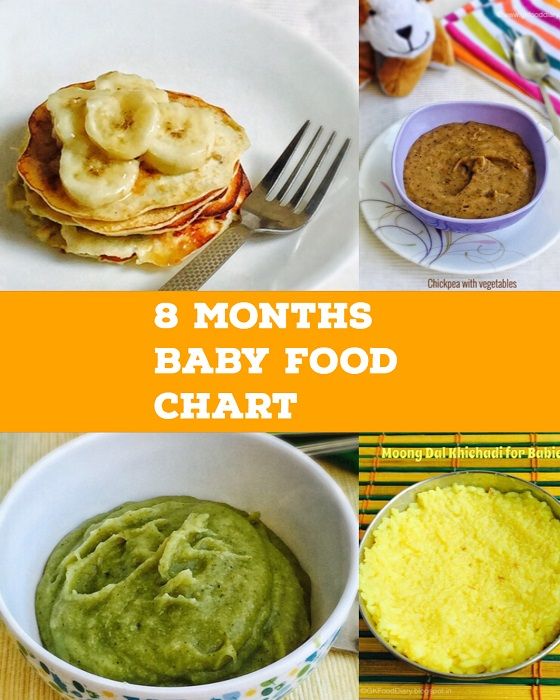 4% DV
4% DV - Thiamin: 6% DV
- Riboflavin: 3% DV
- Niacin: 2% DV
- Pantothenic acid: 2% DV
- Vitamin B6: 6% DV
- Folate: 35% DV
- Vitamin C: 1.8% DV
- Vitamin K: 4% DV
- Calcium: 4% DV
- Copper: 14% DV
- Iron: 13% DV
- Magnesium: 10% DV
- Manganese: 42% DV
- Phosphorus: 13% DV
- Potassium: 7% DV
- Selenium: 4% DV
- Zinc: 8% DV
Chickpeas are an excellent source of folate and manganese. Chickpeas are a good source of iron, copper, magnesium, and phosphorus.
💭 Expert Tips from a DietitianThis is a level 3 recipe (weight maintenance and active lifestyles). Are chickpeas good for babies? Yes, as long as you keep a few important points in mind.
Are chickpeas good for babies? Yes, as long as you keep a few important points in mind.
This baby hummus is packed with protein, fiber, and iron, and is a great option for baby. Just remember that it is never to be used as a nutritional replacement for baby formula or breastmilk.
This recipe is meant to be used as something fun for baby to taste after starting solids. It should not be the main source of nutrition in the diet.
For older members of the family, you can make hummus. Hummus is packed with energy-dense (AKA high calorie) ingredients such as tahini and olive oil.
If you’re an adult trying to maintain the calorie deficit needed for fat loss, I don’t think hummus is a great choice. That said, the relatively high calories and low volume servings in hummus makes it a great snack for growing children.
FAQsAre chickpeas gassy for babies?
Unfortunately, the oligosaccharides in chickpeas can cause some gassiness in babies. It’s smart to start with a small amount to see how your baby reacts; excessive consumption is not recommended! Soaking dried chickpeas, discarding the water, and using fresh water to cook them may help if they are causing discomfort.
It’s smart to start with a small amount to see how your baby reacts; excessive consumption is not recommended! Soaking dried chickpeas, discarding the water, and using fresh water to cook them may help if they are causing discomfort.
Are chickpeas constipating for babies?
The fiber in chickpeas tends to help alleviate constipation, not cause it. There are several things that can cause constipation, such as inadequate fluid intake and certain medications. If your baby is regularly having issues with constipation, it may be a good idea to check in with the pediatrician.
Can you use roasted chickpeas for babies?
Chickpeas can be a choking hazard for babies, so save the whole (hard) roasted chickpeas for older family members. They make a healthy snack at potlucks and playdates for older kids!
How to make black chickpeas for babies?
Make black chickpeas for baby by boiling or pressure cooking them in water until very soft. After they’ve been cooked, you can use them in the chickpea puree for babies recipe below.
After they’ve been cooked, you can use them in the chickpea puree for babies recipe below.
After making this chickpeas baby puree, here are some other recipes for baby food to try:
- Baby Vegetable Stock
- Bone Broth for Babies
- Instant Pot Almond Milk Yogurt (can also be made with dairy milk)
Join our community! Subscribe and be kept up-to-date on the latest and greatest recipes. You can also follow me on Pinterest, Twitter, Instagram, and YouTube!
The Disclaimer…All recipes on this website may or may not be appropriate for you, depending on your medical needs and personal preferences. Consult with a registered dietitian or your physician if you need help determining the dietary pattern that may be best for you.
Consult with a registered dietitian or your physician if you need help determining the dietary pattern that may be best for you.
The nutrition information is an estimate provided as a courtesy. It will differ depending on the specific brands and ingredients that you use. Calorie information on food labels may be wildly inaccurate, so please don't sweat the numbers too much.
For more information on how the three recipe levels may help with a weight management goal, refer to my overnight oats no sugar post. Let's get cooking!
📖 Recipe
Like this recipe?Leave a rating by clicking the ⭐ below!
Chickpeas for Babies (Baby Chickpea Puree Recipe)
Summer Yule
Are chickpeas safe for babies? Yes, you can make pureed chickpeas for babies as part of baby led weaning. It's like baby hummus!
5 from 3 votes
Print Recipe Pin RecipeCook Time 10 mins
Total Time 10 mins
Course Snack
Cuisine American, Middle Eastern
Servings 4
Calories 278 kcal
Food Processor
Juicer
Rubber Spatula
- 15 ounces chickpeas, no added salt (425 grams; from a can)
- 2 tablespoons orange juice, freshly squeezed (fresh lemon juice may also be used)
- ¼ cup water (or more, as needed)
Drain a 15 ounce can of no salt added chickpeas well.
 Place the chickpeas in a food processor or high-speed blender. Add 2 tablespoons of freshly squeezed orange or lemon juice.
Place the chickpeas in a food processor or high-speed blender. Add 2 tablespoons of freshly squeezed orange or lemon juice. If you’re making this whole batch for baby (you’ll need to freeze some) add ¼ cup water. Blend until completely smooth. You will have to stop the food processor several times, scraping down the sides with a spatula, to get a smooth puree.
Add additional water if needed. You can also blend in additional cooked veggies if you wish!
This is a level 3 recipe (weight maintenance and active lifestyles). Are chickpeas good for babies? Yes, as long as you keep a few important points in mind.
This baby hummus is packed with protein, fiber, and iron, and is a great option for baby. Just remember that it is never to be used as a nutritional replacement for baby formula or breastmilk.
This recipe is meant to be used as something fun for baby to taste after starting solids. It should not be the main source of nutrition in the diet.
It should not be the main source of nutrition in the diet.
For older members of the family, you can make hummus. Hummus is packed with energy-dense (AKA high calorie) ingredients such as tahini and olive oil.
If you’re an adult trying to maintain the calorie deficit needed for fat loss, I don’t think hummus is a great choice. That said, the relatively high calories and low volume servings in hummus makes it a great snack for growing children.
Chickpeas for the Family (Hummus)
- 15 ounces canned chickpeas with no added salt (425 grams)
- 2 tablespoons orange juice, freshly squeezed
- 1 clove garlic, finely chopped
- 1 tablespoon tahini
- 5 tablespoons olive oil, divided
- 1 small beet, peeled and chopped (6 ounces/170 grams after peeling)
- ½ teaspoon orange zest
- salt and pepper, to taste
Peel the beet and chop into ¾-inch pieces (1.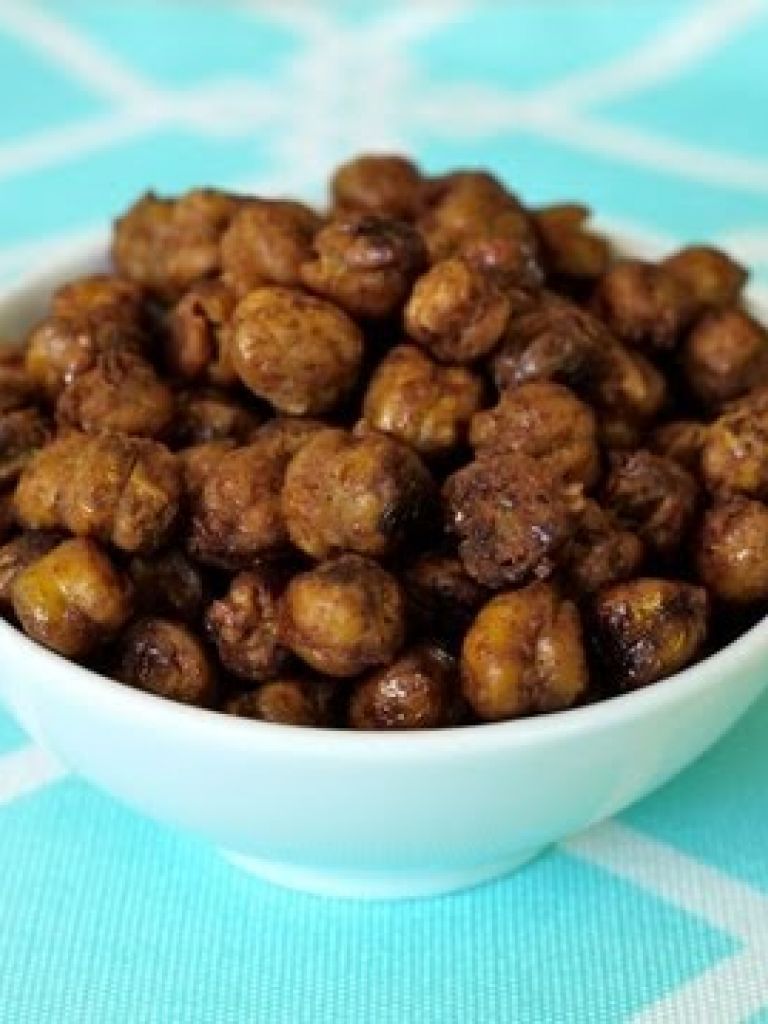 9 cm). Drizzle with 1 tablespoon olive oil and roast in an oven preheated to 400F (200C) for 50-55 minutes. Roast on a rack ⅓ down from the top of the oven, and stir the beets after 30 minutes.
9 cm). Drizzle with 1 tablespoon olive oil and roast in an oven preheated to 400F (200C) for 50-55 minutes. Roast on a rack ⅓ down from the top of the oven, and stir the beets after 30 minutes.
Drain the chickpeas well and add to a food processor with the orange juice. Blend until completely smooth. Remove baby’s portion from the food processor (thin with water as needed).
If you only took a small spoonful out for baby, you can continue with the recipe as written. If you removed a large portion, you may need to halve or quarter the recipe.
Add the roasted beet, garlic, tahini, orange zest, salt, and pepper to the food processor. Turn the processor on and drizzle the remaining 4 tablespoons of olive oil in. Blend the hummus until smooth, stopping the processor several times to scrape down ingredients sticking to the sides with a spatula.
For older family members, this hummus is tasty with crackers or raw vegetable sticks for dipping. Enjoy!
Enjoy!
Nutrition information is for one adult-size serving of hummus (¼ of the “chickpeas for the family” recipe). Babies should just have a small taste of chickpea puree. The nutrition information for chickpeas is listed in the article above.
Calories: 278kcalCarbohydrates: 20.2gProtein: 7.2gFat: 20.5gSaturated Fat: 2.8gPotassium: 59.5mgFiber: 4.5gVitamin A: 0.1% DVVitamin C: 11.6% DVCalcium: 5.6% DVIron: 10.2% DV
Keywords baby chickpea puree, baby chickpeas, baby chickpeas recipe, baby hummus, baby hummus recipe, chickpeas babies, chickpeas baby, chickpeas for babies, chickpeas for baby, pureed chickpeas
Prefer to watch instead of read?Check out my cooking channel!
Chickpea Puree (Homemade Baby Food) • Simple Gray T-Shirt
Home » Recipes » Chickpea Puree (Homemade Baby Food)
Published: by Marni Katz · This post may contain affiliate links
Sharing is caring!
261 shares
- Share
Jump to Recipe - Print Recipe
“This post may contain affiliate links, which means I receive a small commission, at no extra cost to you, if you make a purchase using this link.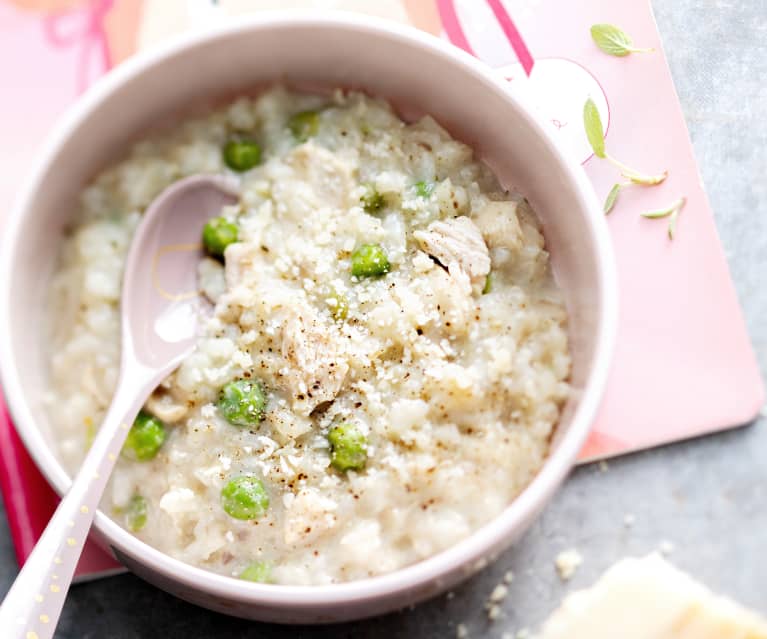 ”
”
Chickpea puree is a great protein to introduce your baby and it's one of the simplest purees for babies that you can make. Spice it up a little bit and call it hummus for babies and the rest of you family can enjoy it too.
This post may contain affiliate links, which means I receive a small commission, at no extra cost to you, if you make a purchase using this link.
Why feed your baby chickpea puree?
In our home, hummus and chickpeas are a staple in our refrigerator and pantry. We like to eat them plain, we like them on salads. We like chickpeas in falafel smothered in hummus, we like them roasted with all sorts of spices. When I started giving my babies hummus, it felt like a natural extension of what we were eating.
Chickpeas are a great source of protein and the main ingredient in hummus. However, hummus also has tahini (sesame paste) in it which is a common allergen, so I wanted to create a recipe with no allergens that was similar and that everyone would still enjoy.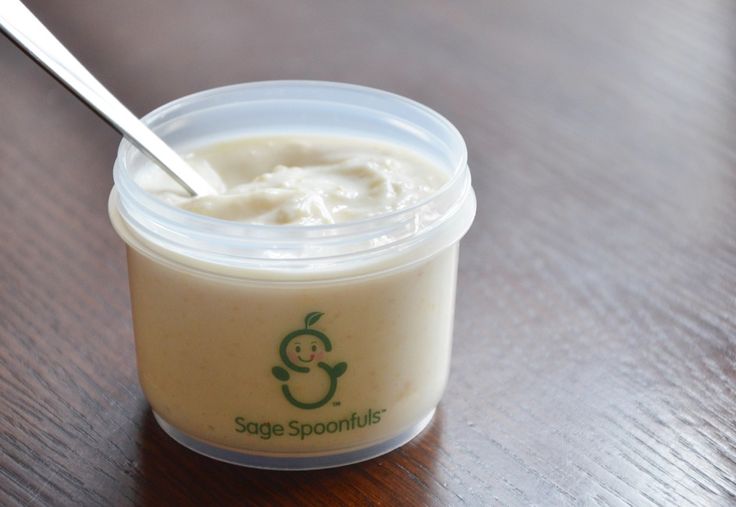
Ingredients for chickpea puree
- Chickpeas: Using canned chickpeas makes this a super quick recipe, however you can also use frozen chickpeas (if you can find them) or soak dried garbanzo beans overnight and then cook them before pureeing.
- Lemon Juice: Fresh squeezed lemon juice helps elevated this from a simple puree to something more akin to hummus for babies.
How to make hummus for babies (
simple step by step instructions)To make things even simpler, here are step-by-step photos to help you every step of the way.
One of the best things about making your own baby food is just how simple it actually is.
For this recipe, simple put all of the ingredients into a high speed blender (I love my Vitamix and it's been going strong for over 5 years!). Then puree until you reach your desired consistency, adding in a bit of water by the tablespoon if you need to thin it out.
For all measurements and a more detailed guide, check out the recipe card at the bottom of this page.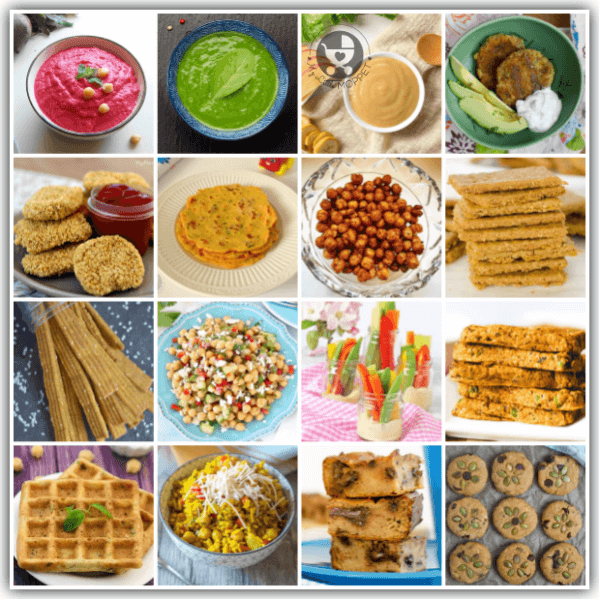
Frequently Asked Questions
What makes chickpeas so healthy?
They are a great source of plant based protein as well as a good source of vitamins and minerals. Chickpeas are high in fiber, which can help digestion in babies and toddlers. Additionally, they have a relatively low glycemic index, which an help regulate blood sugar.
Is this baby food recipe food allergy friendly?
Absolutely. Since we have taken the tahini out of the mix, there are no top allergens found in this recipes.
How do you store chickpea puree?
This puree is best stored in the fridge for up to a week. While you can freeze it in these silicone trays, it can tend to get a little "spongy" when you defrost it. If you do freeze it, when you defrost it, you'll want to mix it with another puree like sweet potatoes, strawberries or even beets.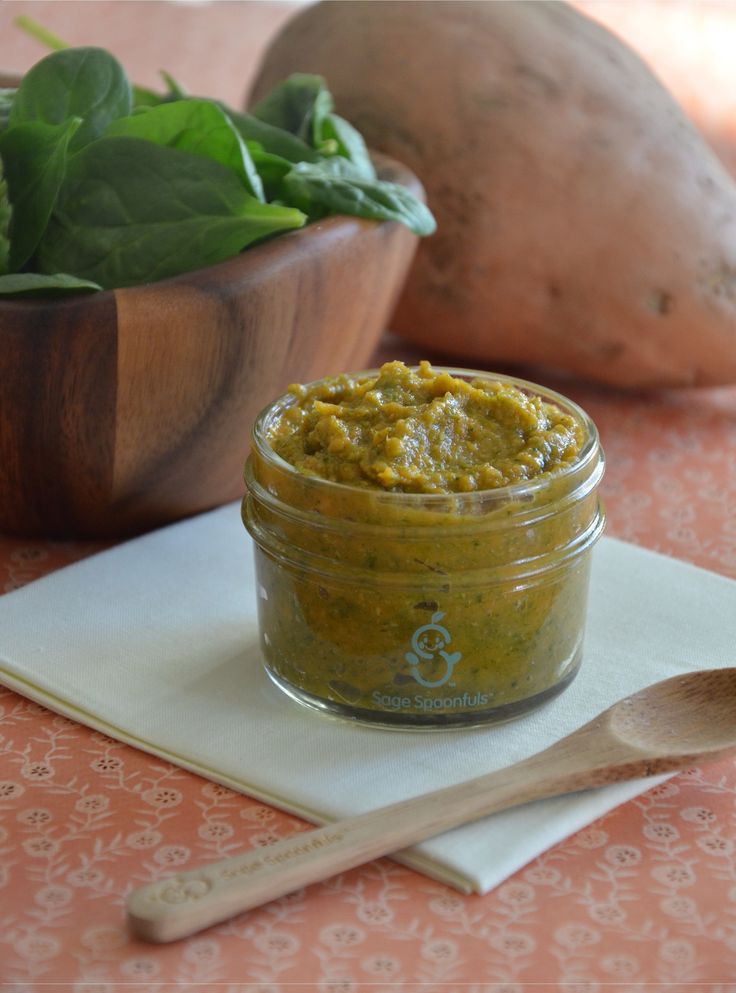
Adding additional flavor to the puree
As chickpeas have such a mild flavor, you can really play with what you pair them with. I like to think of other Middle Eastern/Meditteranean foods and flavors when I’m making my babies foods and pair this puree accordingly:
- Beets: The sweetness in beets pairs nicely with the chickpea and since we eat with our eyes, what baby doesn’t want to eat bright pink hummus?
- Feta: Just mix a small bit of feta into the pureed chickpeas as you are blending it for a bit of a salty bite. It’s a great way to introduce stronger cheeses to your little one and gets them ready for eating things like Greek salad down the road.
- Zatar: A versatile spice blend that can be mixed in with hummus for babies. Read more about it here.
- Olives, roast pepper, roast garlic: Think of what flavors of hummus you see at the grocery and try to emulate them. I would start with these additions chopped up really small and using only a small quantity, but all of them would be delicious for your little one.

One more simple tip
Rinse your chickpeas well. You want to control the salt content in this puree, so be sure to rinse these well. I use a mesh strainer and let the water run over the chickpeas for a minute or two.
This puree can be a bit thick. You can add water a tablespoon at a time if necessary to get it a consistency you like.
Looking for more great homemade baby food recipes? Try these:
- Black Bean Puree
- Carrot Puree
- Pear Puree
When you try this recipe and love it 😍 let me know by leaving a comment below or 5 ⭐ rating!
purees 101 - chickpeas (aka hummus for babies)
Marni Katz
Chickpeas pureed into "hummus for babies"
4 from 4 votes
Print Recipe Pin RecipePrep Time 5 mins
Cook Time 5 mins
Total Time 10 mins
Course Baby Food
Cuisine Mediterranean
Servings 12 cubes
Calories 62 kcal
- 1 15 oz can of chickpeas drained and rinsed
- 1 teaspoon lemon juice fresh squeezed
- salt optional
Rinse chickpeas under water in a mesh strainer.

Put chickpeas into blender with the lemon juice.
Blend to desired consistency.
This puree stays good in an air tight container in the refrigerator for up to 7 days and in the freezer for up to 3 months. When defrosting these cubes, the puree might be a little bit thick. You can thin it out by pairing with a thinner puree, or by adding a bit of liquid (water, formula, breast milk, etc).
Calories: 62kcalCarbohydrates: 10gProtein: 3gFat: 1gSaturated Fat: 1gSodium: 3mgPotassium: 110mgFiber: 3gSugar: 2gVitamin A: 10IUVitamin C: 1mgCalcium: 19mgIron: 1mg
Keyword chickpea puree, homemade hummus, light hummus
Tried this recipe?Let me know what you think!
Want more recipes like this delivered right to your inbox? Be sure to subscribe below and never miss a thing!
Looking for other delicious purees? Check out a few of my favorites and my tips and tricks for making your own:
- Black Bean Puree
- Strawberry Puree
- Ultimate Guide to Making Your Own Baby Food
More Recipes
About Marni Katz
Marni Katz is the recipe developer, photographer and writer behind Simple Gray T-Shirt. She wants to help people keep things simple in the kitchen. With simple recipes, easy menu ideas and plenty of tips and tricks along the way, she wants getting a meal on the table to be as simple as putting on your favorite gray tee!
She wants to help people keep things simple in the kitchen. With simple recipes, easy menu ideas and plenty of tips and tricks along the way, she wants getting a meal on the table to be as simple as putting on your favorite gray tee!
"I want to inspire you to get back in the kitchen and do this, because you can!"
Reader Interactions
is it possible or not? How to cook chickpeas for a child
018.7k.
Contents
Bean and pea dishes are popular in many countries, including Russia. Not everyone is familiar with chickpeas. This product from the legume family has a rich taste, great nutritional value. The question of whether chickpeas can be given to children is often asked by young mothers to specialists. nine0003
Benefits and harms
Chickpeas (chickpeas) contain a huge number of useful substances. A balanced composition allows you to saturate the child's body with all the macro- and microelements, vitamins necessary for growth. The product contains a lot of magnesium, calcium, potassium, phosphorus, ascorbic acid. Chickpeas contain protein, which is necessary for the development of muscle tissue and maintaining the required energy level.
The product contains a lot of magnesium, calcium, potassium, phosphorus, ascorbic acid. Chickpeas contain protein, which is necessary for the development of muscle tissue and maintaining the required energy level.
The high-quality protein contained in Turkish peas quickly saturates the child's body and does not burden the digestive system. nine0003
That is why the product can be used in dietary and vegetarian diets. The regular introduction of chickpeas into the baby's menu helps to increase the body's defenses, gently cleanse the intestines and remove toxins and toxins. Chickpea based meals help regulate blood glucose levels.
- The product is useful for babies suffering from deficient conditions, including anemia. It contains everything necessary to maintain the function of hematopoiesis. nine0024
- Turkish peas normalizes metabolic processes, cellular respiration in the body.
- Its presence in the diet of crumbs helps eliminate skin rashes, strengthen the skeletal system.

The product may also cause adverse reactions. When used, flatulence may occur. Bloating is tolerated by young children quite painfully. Not every child's body quickly adapts to the introduction of Turkish peas into the diet. New food can trigger the development of unpleasant symptoms. nine0003
Chickpeas for children: from what age
Pediatricians do not recommend rushing to introduce legume crumbs into the menu. Children are allowed to give chickpeas from 1.5 years.
Introduce it gradually, starting with ½ teaspoon. It is better to do this in the morning. Thus, it is possible to trace the tolerance of the baby's body to a new product. In the absence of negative reactions, the dosage is increased to 60 g per day.
- At 2-3 years old, you can give your child 70 g of the product. nine0024
- At 4-5 years old, the size of the children's portion increases to 100 g.
In the first months, it is recommended to give the baby chickpeas in the form of puree or puree-like soup. A little later, you can enter stews, cutlets on the menu. Soups are best cooked in vegetable broth. They are well absorbed, do not cause gas formation. Meat broth is allowed to be given to children after 3 years.
A little later, you can enter stews, cutlets on the menu. Soups are best cooked in vegetable broth. They are well absorbed, do not cause gas formation. Meat broth is allowed to be given to children after 3 years.
Chickpeas can be combined with rice, tomatoes, parsley, green salad, garlic.
Chickpea recipes for kids
For baby food, it is important to choose only a quality product. The grain should be smooth, clean, free of plaque and stains.
After purchase, it is important to place the chickpeas in a paper bag or container. It must be stored in a dark place. Chickpeas are recommended to be soaked for 8 hours in clean water. The product must be cooked for at least 1 hour.
Chicken breast puree
Ingredients:
- chickpeas - 1 cup; nine0024
- chicken breast - 200 g;
- cauliflower inflorescences - 50 g;
- olive oil - 1 tablespoon;
- water - 500 ml.

Pre-soaked chickpeas are boiled for 50 minutes. The breast is prepared separately. Inflorescences also need to be boiled for 7-8 minutes. Shredded chicken and chickpeas are placed in the broth left after the cauliflower, whipped with a blender until puree. The mass is heated on fire, combined with cabbage, olive oil. If necessary, you can use the blender again. nine0003
Vegetable soup
Ingredients:
- chickpeas - a glass;
- tomato - 1-2 pcs.;
- carrots - 1 piece;
- bow - 1 pc.;
- garlic clove;
- parsley.
Soaked chickpeas are cooked for 30-40 minutes. Washed and chopped vegetables are boiled until soft, mixed with chickpeas, chopped with a blender. The soup is sprinkled with chopped parsley.
Vegetable cutlets
Ingredients:
- chickpeas - ½ cup;
- carrot - 1 piece;
- bulb - 1 pc.
 ;
; - garlic clove.
Soaked chickpeas are minced and combined with chopped vegetables and a little salt. The mass is again crushed with a blender. Then cutlets are formed from it. The dish can be cooked in the oven or in a double boiler.
Comments 0 Share:Loading ...
Chickpeas in baby food - Telegraph
Feature: Provides the body with all the necessary vitamins. It is added to the children's diet after 1.5 years in the form of mashed potatoes or pureed soups
Chickpeas are brown-green beans, from 0.5 to 1.5 cm in diameter. The surface is rough. It is also called Turkish peas, lamb peas, nahat, shish peas, bladder. Chickpeas have a whole list of names: chickpeas, mutton peas, bladder, nahat, shish peas. nine0003
nine0003
100 grams of chickpea contains 309 kcal
| Vitamins | Macronutrients | Microelements |
| Beta-carotene - 0.09 mg Vitamin A (RE) - 15 mcg Vitamin B1 (thiamine) - 0.08 mg Vitamin PP (niacin equivalent) - 3.3366 mg | Calcium - 193 mg Magnesium - 126 mg Sodium - 72 mg Potassium - 968 mg Phosphorus - 444 mg Chlorine - 50 mg Sulfur - 198 mg | Iron - 2.6 mg Zinc - 2.86 mg Iodine - 3.4 mcg Copper - 660 mcg Manganese - 2.14 mg Selenium - 28.5 mcg Molybdenum - 60.2 mcg Boron - 540 mcg Silicon - 92 mg Cobalt - 9.5 mcg Nickel - 206. Titanium - 228 mcg |
Composition and nutritional properties of chickpeas
- Proteins - 20.1 g
- Fat - 4.32 g
- Carbohydrates - 46.16 g
- Dietary fiber - 9.9 g
- Water - 14 g
- Saturated fatty acids - 0.67 g
- Unsaturated fatty acids - 2.9 g
- Mono- and disaccharides - 2.96 g
- Starch - 43.2 g
- Ash - 3 g
A source of phosphorus, potassium, magnesium, B vitamins. Provides the body with all the necessary vitamins.
Useful properties of chickpeas
Like all legumes, chickpeas are high in protein and carbohydrates. If you regularly eat chickpeas, the level of cholesterol in the body decreases. In addition, chickpeas contain potassium and magnesium, which are beneficial for blood and immunity in general. The stems and leaves of chickpeas contain malic and oxalic acids.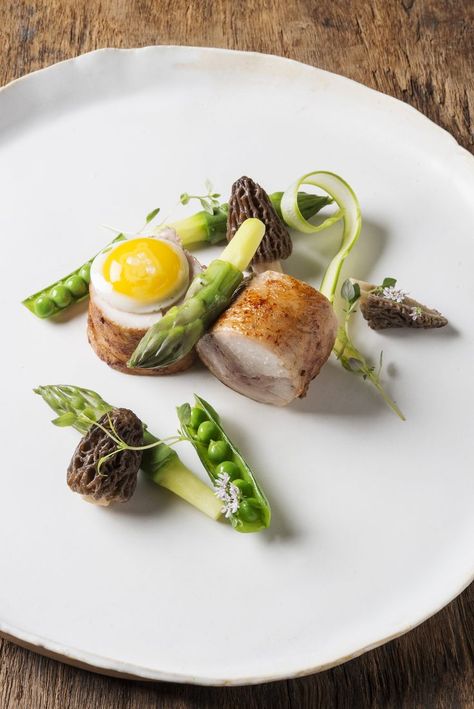 They are also very beneficial for the human body. nine0003
They are also very beneficial for the human body. nine0003
Contraindications for use
You can not use chickpeas with bladder ulcers and in case of individual intolerance. Chickpeas should not be abused, as it contributes to increased gas formation. After eating chickpeas, you should not immediately drink water.
Chickpeas in children's diet
For children, chickpeas must be ground to a homogeneous consistency.
As complementary foods, legumes should be administered in microdoses - 1 tsp, with a gradual increase in the dose to 50-70 g per day for a week. You can add chickpeas to your baby's diet only after they reach 1.5 years. nine0003
Preparation and consistency
Chickpeas taste great. Each of his peas is equipped with a funny nose. Cooking it costs a little longer than ordinary peas. The taste of chickpeas is slightly sweet. It can be perfectly combined with any spices. Chickpeas can be boiled, fried, added to soups, salads, pilaf.
Chickpeas can be boiled, fried, added to soups, salads, pilaf.
Chickpea recipes for children
Roasted garlic hummus
Ingredients:
- Soaked chickpeas - 450 g
- Garlic - 1 head
- Lemon juice - 2 tbsp. l.
- Olive oil - 1 tbsp. l.
- Oregano - 1 tbsp. l.
Cooking:
Separate the garlic into cloves, finely chop and fry (about half a minute so that it does not burn). Then you need to mix all the ingredients in a blender and grind until smooth. nine0003
Chicken Chickpea and Red Cabbage Puree
Ingredients:
- Chickpeas - 1 tbsp.
- Olive oil - 1.5 tbsp. l.
- Chicken breast - 250 g
- Red cabbage - 30 g
- Red dry wine - 2 tbsp. l
- Vegetable broth - 2 tbsp.

- Salt, pepper, thyme
Cooking:
- Soak chickpeas for 8 hours, or better all night, in cold water. Cook chickpeas for about 40-50 minutes until soft. While the chickpeas are cooking, you need to fry the diced chicken breast. Fry for 5-7 minutes until golden brown. nine0024
- Finely chopped cabbage should be fried, then add water. Bring to a boil, simmer over low heat until the cabbage is soft.
- Place boiled chickpeas in a blender, add broth and beat until smooth. Transfer the puree to a saucepan and heat through without boiling.
- Put the puree on a plate, add chilled stewed cabbage and pieces of chicken breasts on top, garnish with fresh thyme leaves and chickpeas.
Chickpea soup
Ingredients:
- Chickpeas - 1 cup
- Tomato - 2 pcs.
- Garlic - 1 clove
- Bulb - 1 pc.
- Black pepper, salt
Cooking:
- Soak the chickpeas overnight.


 4 mcg
4 mcg 
